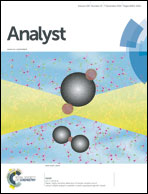Ultraselective electrochemiluminescence biosensor based on locked nucleic acid modified toehold-mediated strand displacement reaction and junction-probe†
Abstract
Locked nucleic acid (LNA) is applied in toehold-mediated strand displacement reaction (TMSDR) to develop a junction-probe electrochemiluminescence (ECL) biosensor for single-nucleotide polymorphism (SNP) detection in the BRCA1 gene related to breast cancer. More than 65-fold signal difference can be observed with perfectly matched target sequence to single-base mismatched sequence under the same conditions, indicating good selectivity of the ECL biosensor.


 Please wait while we load your content...
Please wait while we load your content...